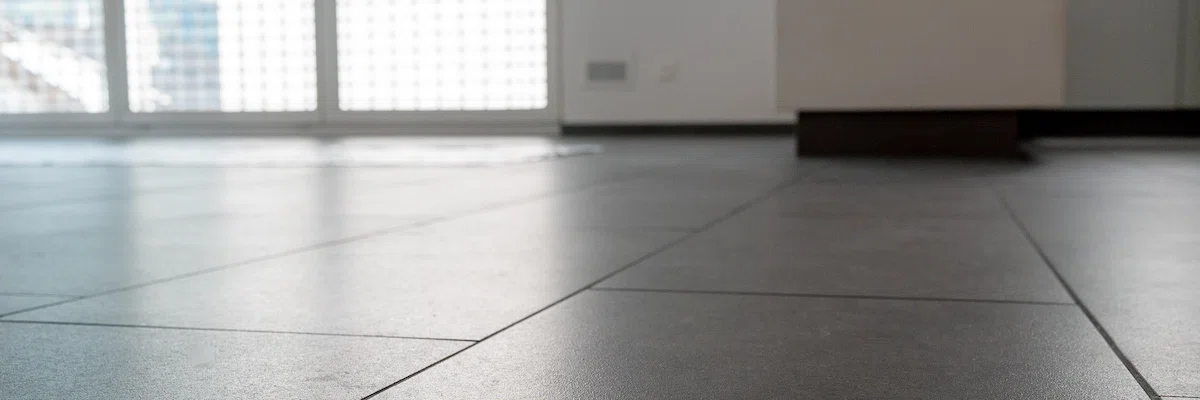

Dragging a chain, bouncing a golf ball, tapping a putter or some other hard object across a ceramic tile floor may be an indicator of a failure issue, but before we jump to the proverbial conclusion, more investigation and/or understanding may be needed.
The immediate “cause” conclusion may include:
- Mortar skinning
- A bond breaker on the back of the tile
- A bond breaker on the substrate
- Wet cuts being set immediately after leaving the wet saw table
- Wrong trowel
- Tile that is warped
- Lack of substrate prep
- Spot bonding
These conditions can contribute to hollow-sounding tile either by themselves or in combination with other factors. We will explore each of these potential situations and determine if a failure is around the corner.
The Tile Council of North America (TCNA) Handbook provides excellent guidance in the operation of the tile installation which is found under “Finished Tilework.” It states: “To avoid damage to finished tilework, schedule floor installations to begin only after all structural work, building enclosure, and overhead finishing work, such as ceilings, painting, mechanical, and electrical work, are completed. Keep all traffic off finished tile floors until they have fully cured. Builder shall provide up to 3/4"-thick plywood or OSB protection over non-staining kraft paper to protect floors after installation materials have cured.”
Mortar skinning
Allowing tile setting mortar to skin over can be a result of several sources. Troweling out more mortar than can be covered in 15 or 20 minutes (depending on the manufacturer’s recommendations) will dry out on the surface – or skin over – which will inhibit proper transfer to the back of the tile.
Skinning can also be caused by the site not being environmentally friendly or ready for tile installation. Missing doors or windows or a door left open to provide comfort to the installers will allow air to pass over the mortar impeding a good bond.
The ANSI A108.5-2.2.2 standard reinforces this requirement stating in part; “Apply mortar with flat side of trowel, keying in with pressure, over an area no greater than can be covered with tile before the mortar skins over.”
Mortar that skins over will inhibit transfer to the back of the tile.
Bond breaker on tile/wet cuts
Any time tile is being installed, it is wise to wipe your hand across the back of the tile to determine if a contaminant is present. This list could include:
If excessive kiln release dust is applied to the back of the tile, the bond will be compromised.
- The kiln release dust, when properly applied during production, allows the tile to move freely from the conveyor after traveling through the kiln firing process. If excessive kiln release dust is applied to the back of the tile, the bond will be compromised.
- A chalky residue consisting of water and tile or natural stone dust resulting from cutting on a wet saw or dust from using a dry-cutting method.
- Dust (other than kiln release) from the manufacturing process, transportation, or on-site conditions.
- Water on the back of the tile from cutting on a wet saw can act as a bond-breaker. This situation is sometimes known as the disappearing bond breaker. The water on the back of the tile is absorbed by the mortar, leaving the tile looking as if it was fresh out of the box. This circumstance is like a vehicle tire hydroplaning on a wet highway.
Bond breaker on substrate
Likewise, the substrate, whether concrete or wood, must be clean. For tile installed over a concrete substrate, ANSI A108.01-2.6.2.2 states in part: “Surfaces must be clean, free of wax, curing compound, and other coatings.” ANSI A108.01-3.2.1.2; states: “Cure concrete slabs that are to receive tile before tile application. Do not use liquid curing compounds or other coatings that may prevent bonding of tile setting materials to slabs.” On a plywood substrate, ANSI A108.01-2.6.2.4 states: “Surfaces must be structurally sound, dry, and free of contaminants such as sealers, cleaning compound, coatings, oil, dust, dirt, etc.”
Water on the back of the tile from cutting on a wet saw can act as a bond-breaker.
Wrong trowel
Using the wrong trowel that does not provide enough mortar to contact the back of the tile will also yield poor results.
ANSI A108.5-2.2.2 states: “To obtain a setting bed, use a notched trowel of type recommended by mortar manufacturer, comb mortar with the notched side of the trowel in one direction. Cover surface uniformly with no bare spots and with sufficient mortar to insure a minimum mortar thickness of 3/32 in. (2mm) between tile and backing after tile has been forcibly embedded. Tile shall not be applied to skinned mortar.”
Lack of coverage on the back of the tile will result in inadequate bond.
ANSI A108.5-2.2.3 states: “Contact area shall not be less than 80%. Contact area on all exterior installations or interior wet installations, shall not be less 95%. The 80% or 95% coverage shall be sufficiently distributed to give full support of the tile with particular attention to all corners and edges of the tile. To achieve the 80% or 95% coverage required in the project specifications, select a notched trowel sized to facilitate the proper coverage. It may be necessary to flat back trowel individual tile with bond coat to achieve the proper coverage.”
Substrate preparation
Substrate preparation is critical to eliminating hollow-sounding tile. If the prep is not completed, creating a substrate that is flat enough to provide an appropriate bond to the tile, the area in question should be corrected by using a flash patch in smaller areas or using a flowable hydraulic cement underlayment (formerly SLU) with the same manufacturer’s primer.
Spot bonding
The trick of spot bonding tile continues to be the nemesis of the tile industry. The voids left between the dabs of mortar provide both a failure point and hollow-sounding echo chamber. For more information on spot bonding, please follow these links.
https://bit.ly/3LCFfY8
https://bit.ly/3nnMnj6
All the above situations and requirements speak to the possibility of producing hollow sounding tile. However, the difference in tone may come from another source. According to the Handbook Membrane Selection Guide, Considerations When Using Membranes, “Membranes installed properly can produce hollow-sounding tiles. This is not indicative of loss of bond with concomitant installation issues.”
The answer to this article question is: not always!
The voids left between dabs of mortar provide both a failure point and hollow-sounding echo chamber.






